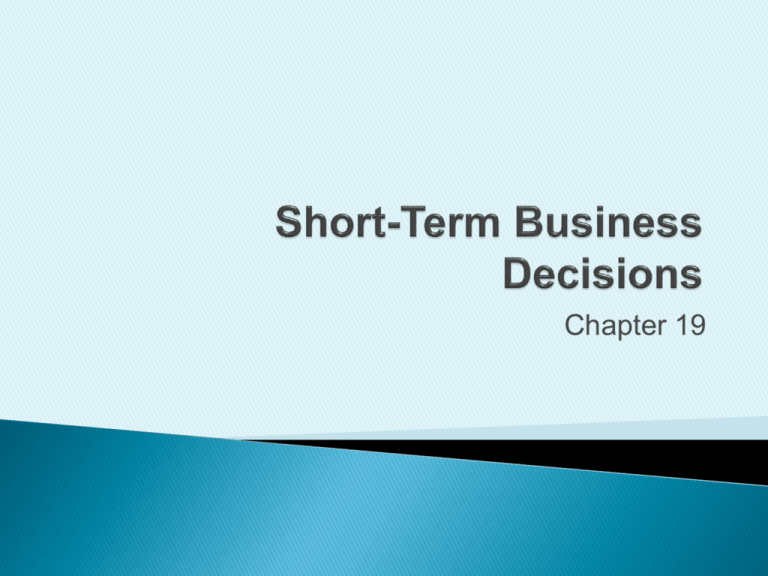
Chapter 19
Describe and identify information relevant to
business decisions
Define business goals
Identify alternative courses of
action
Gather and analyze relevant
information
Compare alternatives
Choose best alternative
Copyright (c) 2009 Prentice Hall. All rights reserved.
3
Expected future data
Differs among alternatives
Relevant costs
Copyright (c) 2009 Prentice Hall. All rights reserved.
4
Do not affect decision
Sunk costs
Copyright (c) 2009 Prentice Hall. All rights reserved.
5
Managers need to consider qualitative factors in
decision-making
Use same guidelines as relevant costs
Copyright (c) 2009 Prentice Hall. All rights reserved.
6
Incremental analysis
Copyright (c) 2009 Prentice Hall. All rights reserved.
7
Make special order and pricing decisions
Is there excess
capacity?
Will the reduced
price cover the
incremental
costs?
Will special
order affect
sales in the
long-run?
Copyright (c) 2009 Prentice Hall. All rights reserved.
9
Is there excess
capacity?
?
?
Consider
further
Reject the
special order
Copyright (c) 2009 Prentice Hall. All rights reserved.
10
Does reduced
price cover
variable
costs?
?
Consider
fixed costs
?
Reject the
special order
Copyright (c) 2009 Prentice Hall. All rights reserved.
11
Will regular
customers find
out and demand
a lower price?
Will special order
customer
demand lower
price on a
regular basis?
Will special order
start a price war
with
competitors?
12
Expected increase in
revenues
50,000 packs x .37
$18,500
Expected increase in
variable costs
Expected increase in
operating income
50,000 packs x .32
16,000
ACCEPT
$ 2,500
If $5,800 of costs will be incurred,
then Active-Cardz should decline.
Copyright (c) 2009 Prentice Hall. All rights reserved.
13
What is our
target profit?
How much will
customers
pay?
Are we a
price-taker or
a price-setter?
Copyright (c) 2009 Prentice Hall. All rights reserved.
14
Product lacks
uniqueness
Intense competition
Pricing approach
emphasizes target
pricing
Price-takers
Product is more
unique
Less competition
Pricing approach
emphasizes cost-plus
pricing
Price-setters
Copyright (c) 2009 Prentice Hall. All rights reserved.
15
Revenue at market price
Less: Desired profit
Equals Target full cost
Includes product
and period costs
Copyright (c) 2009 Prentice Hall. All rights reserved.
16
Full cost
Plus: Desired profit
Equals Cost-plus price
Copyright (c) 2009 Prentice Hall. All rights reserved.
17
DECISION RULE:
How to Approach
Pricing?
Is company a
price-taker for the
product?
Is company a
price-setter for
the product?
?
?
Copyright (c) 2009 Prentice Hall. All rights reserved.
18
Make dropping a product and product-mix
decisions
Does the product
provide a positive
contribution
margin?
Will fixed costs
continue?
Will the sales of
other products be
affected?
Can any fixed
costs be avoided
if we drop the
product?
What could we
do with the freed
capacity?
Copyright (c) 2009 Prentice Hall. All rights reserved.
20
Two keys
◦ Focus on relevant revenues, costs and profits
◦ Use a contribution margin approach
Focus now on a decrease in volume
Copyright (c) 2009 Prentice Hall. All rights reserved.
21
Product has a negative contribution margin
Unavoidable fixed costs are irrelevant
Avoidable, direct fixed costs are relevant
Copyright (c) 2009 Prentice Hall. All rights reserved.
22
DECISION RULE:
Drop a product,
department, or territory?
Are lost revenues >
cost savings?
Are lost revenues <
cost savings?
?
?
Copyright (c) 2009 Prentice Hall. All rights reserved.
23
Expected decrease in revenues
Expected decrease in variable costs
Expected decrease in operating income
$129,000
93,000
$36,000
What do you do?
Copyright (c) 2009 Prentice Hall. All rights reserved.
24
Restrict production or sale of product
Manufacturers
◦ Limitations on labor or machine hours or available
materials
Merchandisers
◦ Amount of display space
Stiff competition may limit demand
Copyright (c) 2009 Prentice Hall. All rights reserved.
25
What constraints
stop us from
making all the units
we can sell?
Which products
offer the highest
contribution margin
of the constraint?
Would emphasizing
one product over
another affect fixed
costs?
Copyright (c) 2009 Prentice Hall. All rights reserved.
26
DECISION RULE:
Which product to
emphasize?
?
Copyright (c) 2009 Prentice Hall. All rights reserved.
27
Make outsourcing and sell “as is” or process
further decisions
How do variable
costs compare to
the outsourcing
costs?
Are any fixed
costs avoidable if
we outsource?
What would we
do with the freed
capacity?
Copyright (c) 2009 Prentice Hall. All rights reserved.
29
DECISION RULE: Should the company outsource?
If the incremental costs of
making exceed incremental
costs to outsource
If the incremental cost of
making are less than the
incremental costs to
outsource
?
?
Copyright (c) 2009 Prentice Hall. All rights reserved.
30
The benefit forgone by not choosing an alternative
course of action
Copyright (c) 2009 Prentice Hall. All rights reserved.
31
How much
revenue will be
earned if sold “as
is”?
How much
revenue will be
earned if
processed further?
How much will it
cost to process
further?
Copyright (c) 2009 Prentice Hall. All rights reserved.
32
DECISION RULE: Sell as is or
process further?
If extra revenue from
processing further
exceeds extra cost
If extra revenue from
processing further is
less than extra cost
?
?
Copyright (c) 2009 Prentice Hall. All rights reserved.
33








